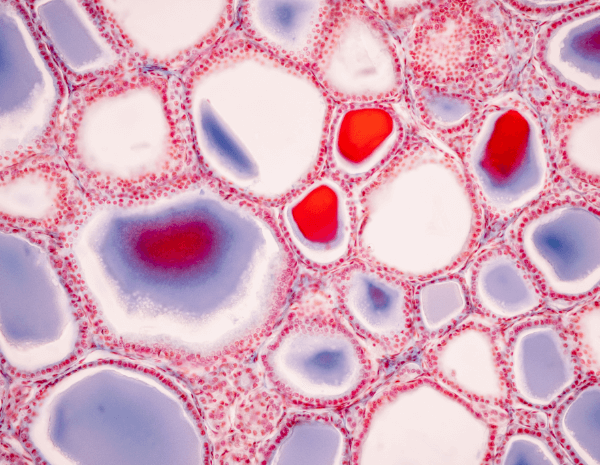Our Medical Director, Dr Gaby, shares the inner workings of our hormones and skin, and how we can support both.
Did you know? Your skin can make its own hormones.
But first, let’s start with how our skin is connected to our endocrine system – a.k.a. the messenger system that delivers hormones around the body.
What is the endocrine system?
The endocrine system is essential to the optimal functioning of the human body. It consists of several endocrine glands that release hormones, which are chemical messengers, into the circulation. These spread throughout the whole body through the blood, regulating all of our organs including the skin.
Some of the most well-known endocrine glands are the pineal gland, pituitary gland, thyroid, ovaries and testes, and adrenal gland. What many of us don’t know is that skin also functions as an endocrine organ and can make hormones. These hormones act on the skin and also enter into our circulation, affecting the rest of the body.
How does the skin make hormones?
One of the best-known hormones made by skin is vitamin D. Skin also produces melatonin, the hormone that regulates our internal clock, and serotonin, a key hormone that stabilises mood and improves feelings of wellbeing.
The skin makes sex hormones such as oestrogens, testosterone and other androgens. It might even be able to covert T4 (thyroxine) into the active T3 (triiodothyronine), the thyroid hormones which are involved in regulating our metabolism.
Can stress affect the endocrine system?
Recently, there has been increasing awareness of stress, both in terms of psychological stress and the physical stress caused by pollution and the environment. When we feel stressed, the brain triggers the adrenal gland to secrete epinephrine and norepinephrine, the neurotransmitters responsible for the fight-flight response.
The brain also triggers a cascade of hormones, the hypothalamic-pituitary-adrenal (HPA) axis, which ultimately stimulates the adrenal gland to secrete cortisol, the main stress hormone. Linked to this stress response is an increase in the production of melanocyte stimulating hormone. These hormones and neurotransmitters lead to the symptoms of stress, such as increased heart rate, shortness of breath, muscle tension and sweating, as well as its long-term effects. This impacts our whole body, including our skin.
How can stress hormones impact our skin?
In addition to responding to stress hormones, skin also has its own fully functional HPA axis. This means skin produces all the hormones in the stress response cascade, as well as epinephrine and norepinephrine, the stress neurotransmitters. The system is triggered in skin by circulating stress hormones, but also by environmental stressors such as UV radiation, inflammation or injury to the skin.
Cortisol and other stress hormones and neurotransmitters produced by the skin and from the general stress response affect many of skin’s components. They lead to decreased proliferation and increased differentiation of keratinocytes, leading to thinning of the epidermis and stratum corneum. Ceramides become depleted affecting the skin barrier. Melanocytes proliferate increasing melanin production, and sebocytes proliferate increasing sebum production. The skin immune system is impaired, inflammation increases and the skin microbiome is disrupted. In addition, mast cells release histamine causing itching and blood vessel dilation with increased flushing.
These changes contribute to an impaired skin barrier function, delayed wound healing and increased flare-ups of skin conditions such as eczema, psoriasis, acne and rosacea, as well as accelerated aging.
How can we support our skin and hormonal changes?
Far from being a passive organ in our bodies, skin plays an active role in many integral processes, including as part of the endocrine system. Keeping skin healthy with careful topical skincare has benefits for wellbeing beyond aesthetics – ensuring that our skin can adequately play its vital roles within the body and safeguarding these processes as we age.
Nutrition is also super important to support our skin health and whole-body health. Our bodies need to maintain a stable blood sugar level. When our blood sugar drops too low, a stress response is generated to release more fuel. This stress response has the same effect as being stressed about a deadline. To avoid it, eating regularly is important. Some people feel better eating two meals a day and some need five smaller meals. Everyone is different, so listen to the body and find what works best.
A well-rounded diet ensures our skin has everything it needs to function. Vitamin A is essential for skin cell renewal and all-round skin health, found in red and orange foods like carrots, mangos, sweet potatoes and red peppers, as well as spinach. These are all great options to help support skin and the endocrine system, for optimal health and wellbeing.
References:
Slominski and Wortsman, Neuroendocrinology of the skin. Endocrine reviews 2000; 21 (5): 457-487
doi: 10.1210/edrv.21.5.0410.
Zouboulis, Human skin: an independent peripheral endocrine organ. Horm Res 2000; 54:230-242
https://doi.org/10.1159/000053265
Rechrath, The skin is a fascinating endocrine organ. Dermato-Endocrinology, 1:4 195-196 2009
https://doi.org/10.4161/derm.1.4.9653
Chen and Lyga, Brain-skin connection: stress, inflammation and skin aging. Inflammation and allergy – drug targets 2014, 13, 177-190
doi: 10.2174/1871528113666140522104422.




